Belgian side R.S.C Anderlecht have a proud tradition of producing and nurturing plenty of excellent young players. The likes of Leander Dendoncker, Youri Tielemans and Romelu Lukaku all came through their notorious academy. Current first-team manager Vincent Kompany also learnt his trade at Lotto Park before becoming a legend at Man City.
With Les Mauves et Blancs sitting midtable in the Belgian Pro League, it’s fair to say Kompany’s first season in management hasn’t gone according to plan. But he has had the pleasure of overseeing teenage prodigy Yari Verschaeren thrive in their first team set-up this campaign. The 18-year-old is already a full Belgian international, having earnt three caps last year. His playing style has drawn comparisons with international teammate and Real Madrid star Eden Hazard.
This scout report will provide a tactical analysis on one of the latest talents on Anderlecht’s illustrious production line.
Overview
Verschaeren played a total of 1,492 minutes for Anderlecht in 2019-20, spanning across 21 matches. He managed two goals and 2.74 expected assists (xA) so far. The youngster also has a goal for his country, after he stepped up to take a penalty in Belgium’s 9-0 win over San Marino in Euro 2020 qualification. Verschaeren usually plays on the right wing in a 4-3-2-1 formation, but he’s also capable of playing centrally and on the left.
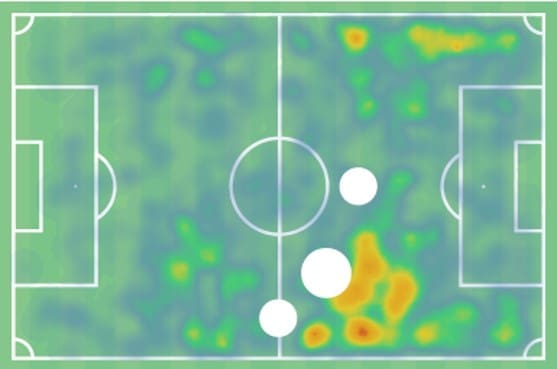
His heatmap shows that as well as being heavily involved down the right, he’s also given the license to roam into the half-space and centre of the pitch. The 5ft 8 star isn’t your traditional winger who will aim to make direct runs with the ball towards the byline. He’s capable of doing that, but Verschaeren is an intelligent footballer who plays with his head up, and often comes inside to combine with his teammates between the lines.
Off the ball movement and pressing
The analysis will now focus on the youngster’s off the ball movement and general role in Vincent Kompany’s team. Although he enjoys roaming infield and linking up with his teammates when he has the ball, Verschaeren hugs the touchline and retains his width when his teammates are in possession.
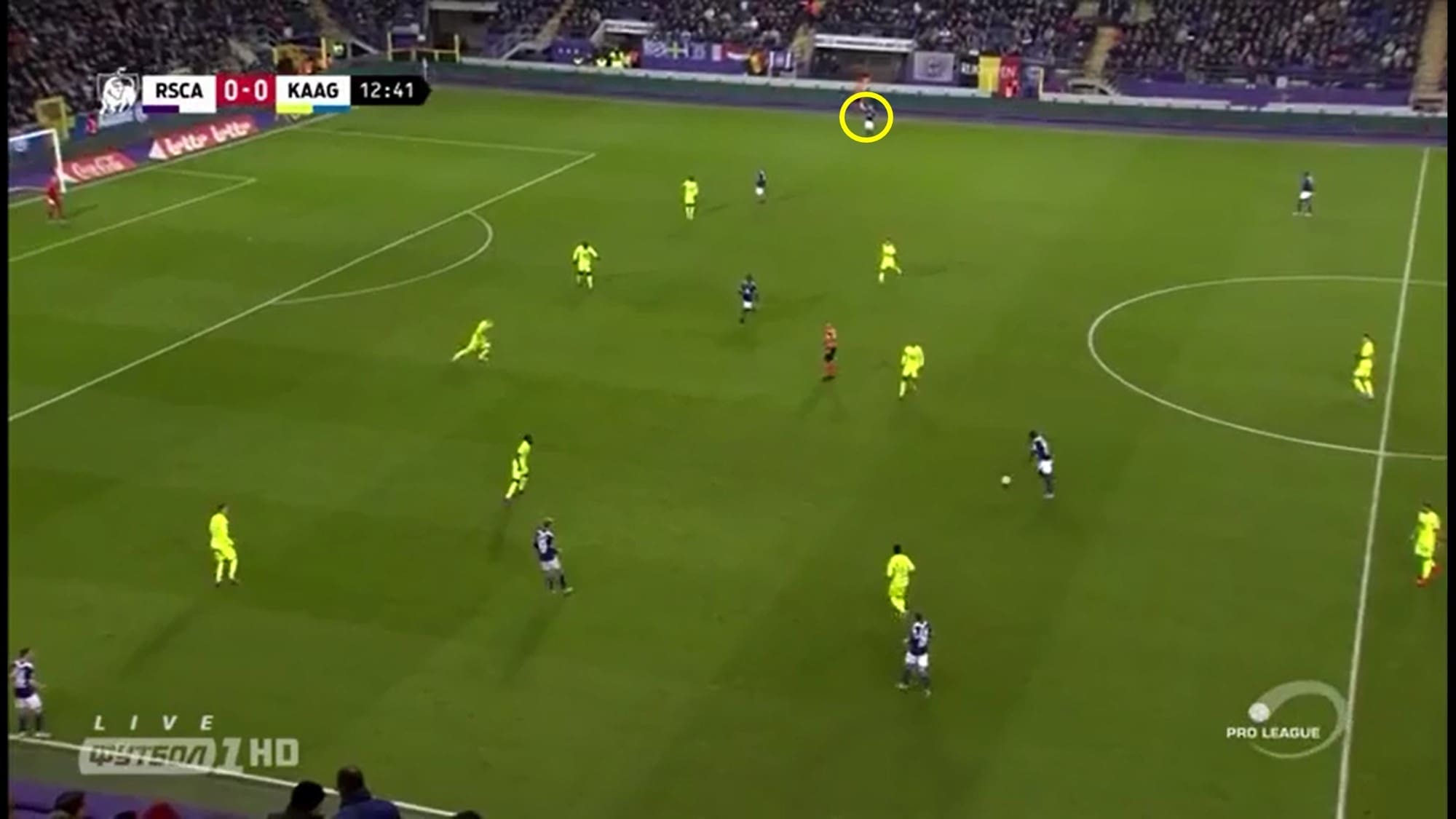
As you can see in the image above, both wingers are hugging the touchline and stretching the play. This creates a decisional problem for both full-backs. If they mark the wingers they’ll leave the half-space open to be exploited. Because Verschaeren is hugging one touchline and his opposite winger is on the other, there is plenty of space between each defender for Anderlecht to exploit if they decide to attack down the middle.
On this occasion, they switched the ball out to Verschaeren, who was able to control the ball in plenty of space. His willingness to hug the touchline means that the teenager is available as an out ball if Kompany’s side want to switch the point of attack, but his positioning also helps stretch the opposition and create space to attack through the middle.
When Anderlecht have the ball on the opposite side, Verschaeren looks to ghost in at the back post. Below is the run he made before scoring against Gent last season.
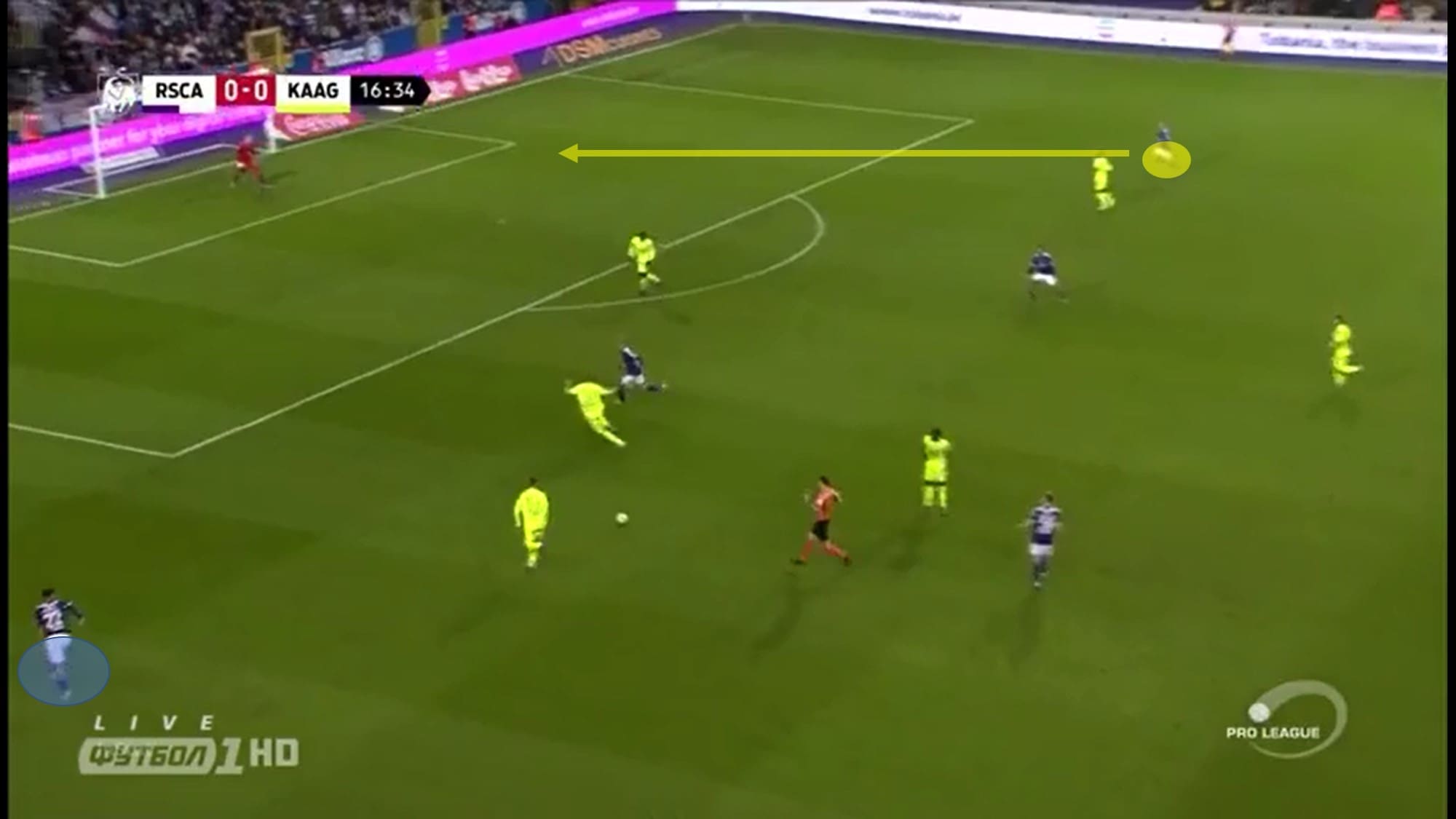
Even though they’ve got the ball down the left flank, the youngster retains his width. By doing this, he’s operating on the blind side of the opposing full-back, who has to keep an eye on the play. When his teammate Elias Cobbaut gets closer to the byline, he makes a run across the full-back’s inside shoulder towards the back post. Cobbaut pulls the ball back, and Verschaeren manages to bundle the ball in.
It was a classic case of the winger on the far side gambling and attacking the back post when his opposite number has the ball in a promising area. Simple, but very effective.
Interestingly, despite his pretty slight frame, Verschaeren won 66% of his defensive duels last season. That’s the best success rate out of all players in his position. He was involved in 6.03 defensive duels per 90 minutes, which was around the average for Belgian Pro League wingers last term. So why does he tend to win a lot of these duels? A lot of it is down to the intelligent way he presses opponents. Below is an example of him doing that.
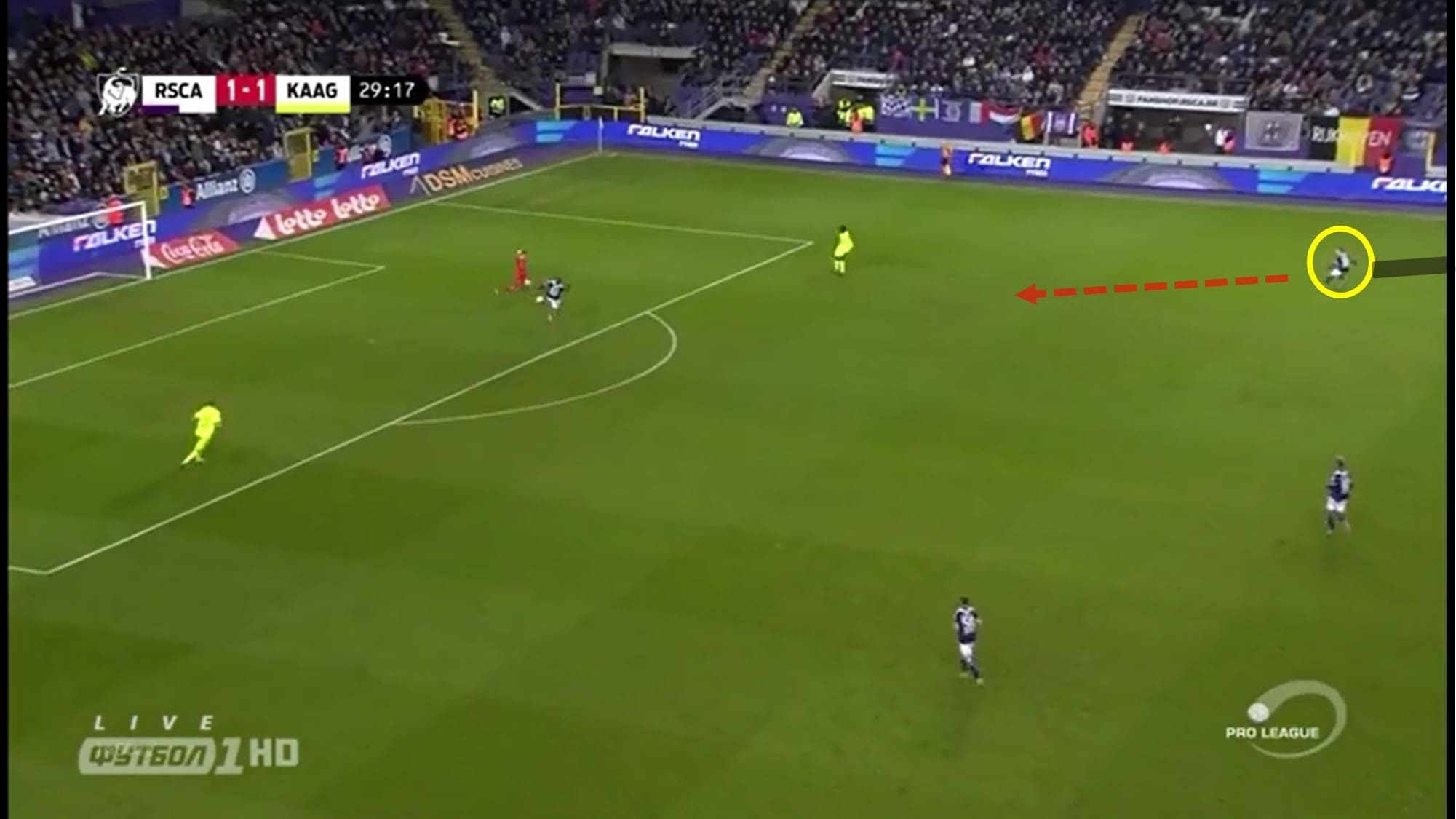
The opposition full-back is out of shot, but he’s taken up a higher position hugging the left touchline. If Verschaeren went tighter to him, he’d have left a lot of space for Gent’s left-sided central defender, if the goalkeeper had passed the ball out to him. So he takes up a position where he can go and press the centre-back if the goalkeeper passes the ball to him. The full-back is also in his cover shadow.
The ‘keeper decides not to risk passing the ball out to the centre-back, so he sends a lofted pass out to the left-back. Verschaeren is then well-positioned to make the sprint back and apply pressure on the receiver. By doing that, he forced a turnover in a good position for his team.
Creativity and passing
Anderlecht’s tactics are based around keeping the ball and being patient in possession. They averaged 56% of possession per game, which was the third-highest in the league last season. Their average duration of possession was 16.2 seconds, which is the joint-most in the division. So it’s clear that they need players who are capable of passing, and Verschaeren certainly is.
His overall passing accuracy was 82.17%. In terms of his forward passing completion rate, he ranked joint fourth out of all wingers in the league with 76.19%.
The 18-year-old assumes the responsibility of being a wide playmaker in possession. He tends to take up wide starting positions, but he enjoys drifting infield to combine with his teammates.
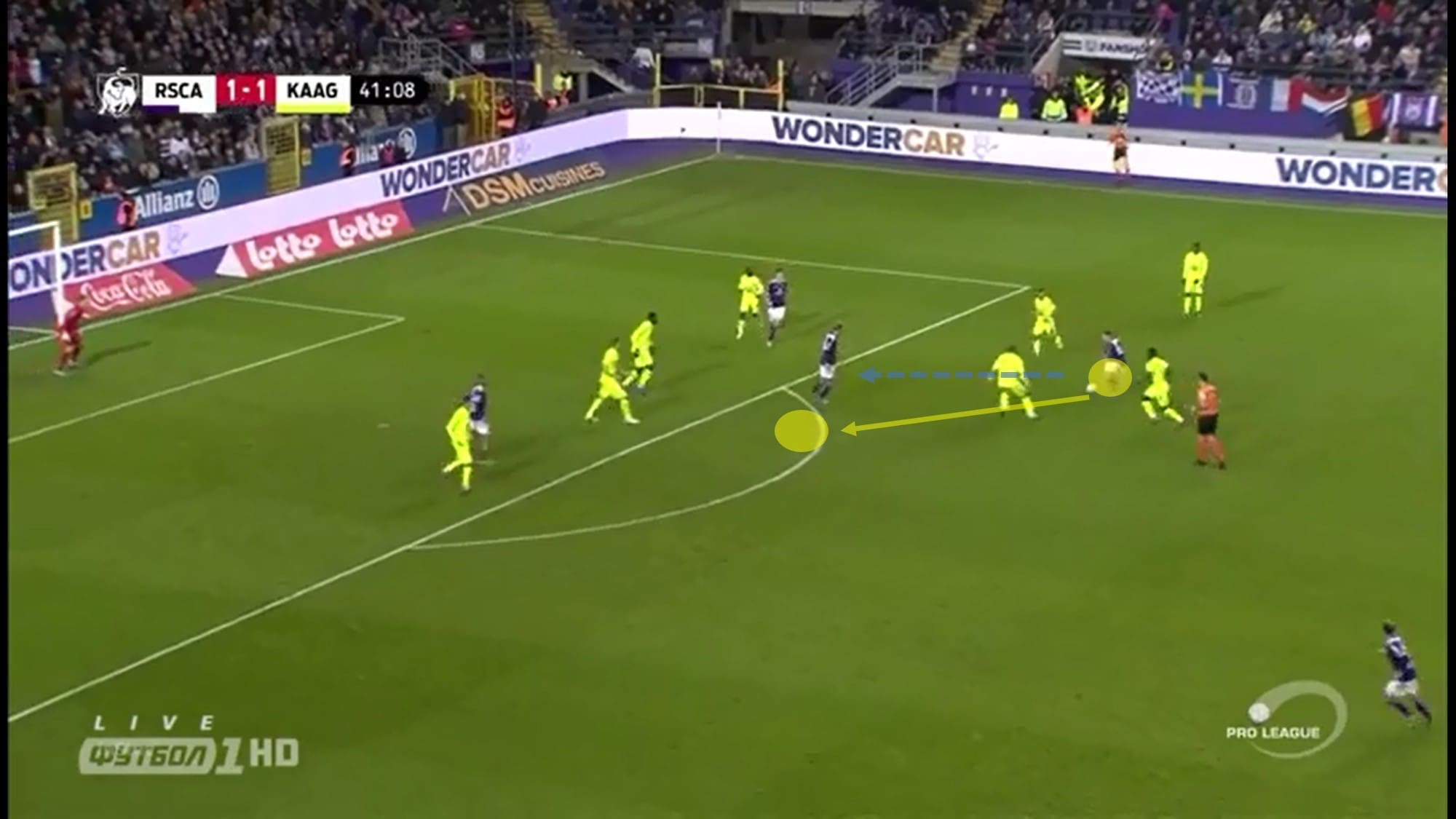
In the image above, he’s drifted inside to play a quick one-two with his teammate. In these situations, Verschaeren is excellent at delivering a crisp pass and immediately getting on the move to create a return passing option. He recognises that playing quick, intricate, passes between the lines is a better, safer way of progressing the ball than blindly trying to run past players.
The wonderkid always plays with his head up, as you can see in the example below.
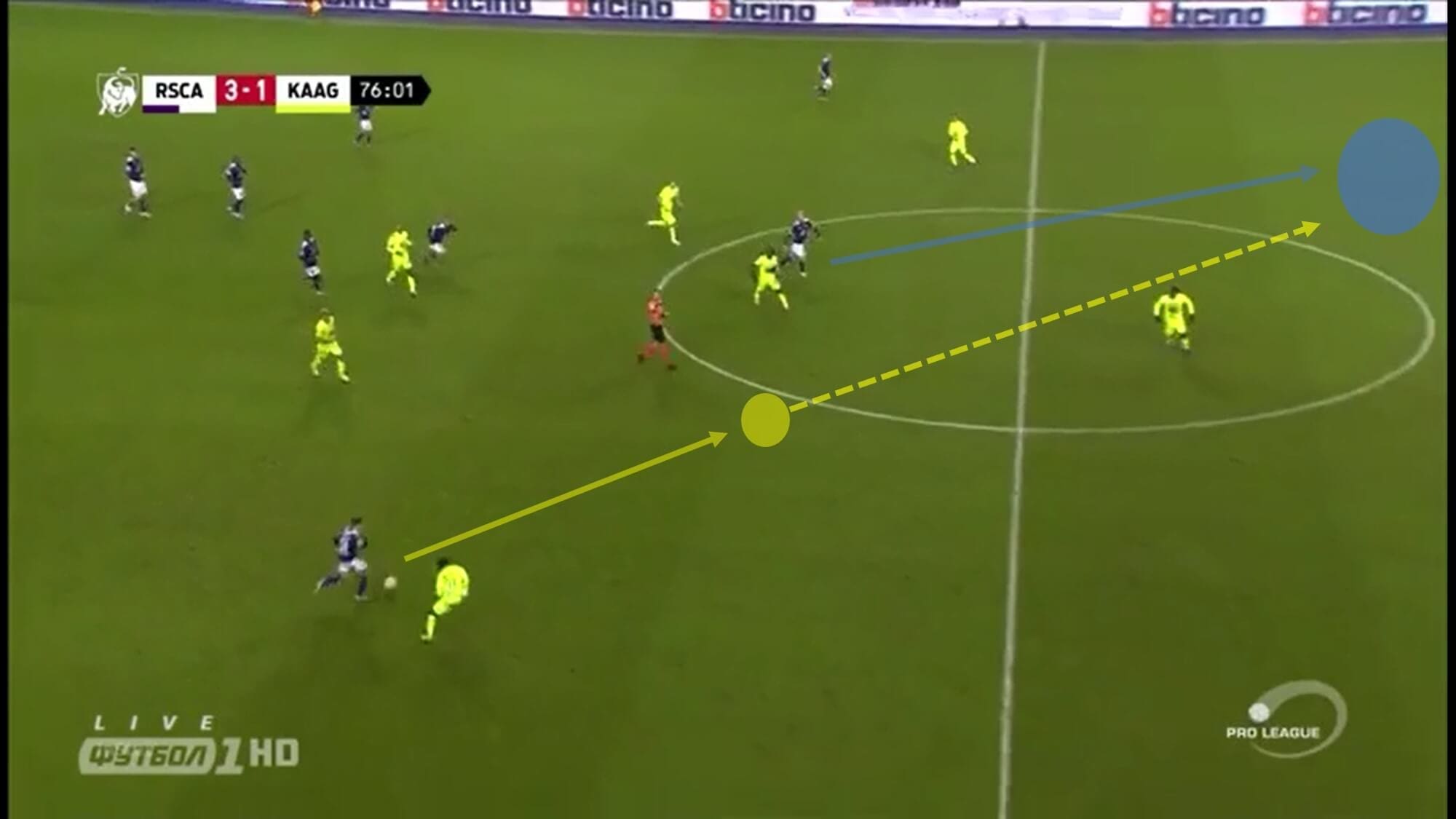
Because he is equally comfortable taking the ball inside as he is going down the outside, it’s hard for opposing full-backs to guess which way he’s going to go in possession. If the defender shows him on the inside, he’s happy to take the ball into that area. This gives him that extra yard of space. You can see that happening in the image: just one touch and he’s able to take the ball away from the defender and into the area just outside the centre circle.
From that point, he looks up and delivers a well-weighted through ball into his teammate. His ability to drift inside and play passes like this helps change the direction of attack for Anderlecht. This means that their opponents can lose their defensive structure. As you can see, the defender in the centre circle turns his attention and body shape to deal with the threat that’s emerging down the right.
Because Verschaeren can instantly change the direction of attack, the defender then has to shift his body weight to change direction and readjust deal with the threat inside. He also has to change the way he’s facing, as the striker on his blindside then becomes the biggest threat. This is very difficult to do, and it results in opponents losing their defensive structure against Anderlecht.
Below are two visuals that represent his statistical involvement in attacks, due to his ability to get on the ball and combine with teammates.

Both of these graphs show how Verschaeren ranked against other outfield players in the Belgian Pro League. The expected goals (xG) chain is a metric that measures general attacking output. It assigns the xG value of a shot to any player that made an action leading to the shot. Verschaeren’s average of 0.67 ranked him higher than the vast majority of players in his league.
The graph on the right side displays his xG Buildup per 90 minutes. This is the xG chain minus the xG value of the actual shot and the xA value of the shot assist. Verschaeren’s numbers for this metric stack up well, which suggests he’s also well-involved in the build-up from deeper areas.
Although he’s not placed right at the top of the league in these metrics, those numbers are still very impressive for an 18-year-old. Clearly, he’ll only get much better and have more influence on games as he matures.
Dribbling and two-footedness
For Anderlecht, the teenager doesn’t attempt a huge amount of dribbles. He averaged 3.26 dribbles per 90 minutes, which is very low compared to other players in his position. This is down to Anderlecht’s style of play, and the fact that he’ll often look to progress the ball through combination play with his teammates. However, Verschaeren is still a good dribbler. He has excellent ball control, agility, a low centre of gravity, and he’s two-footed.
That ability to take the ball on the inside or outside, on the right foot or left foot makes him so much harder to defend against. The example below shows how he created half a yard of space for himself to score in last summer’s Euro Under 21 competition.
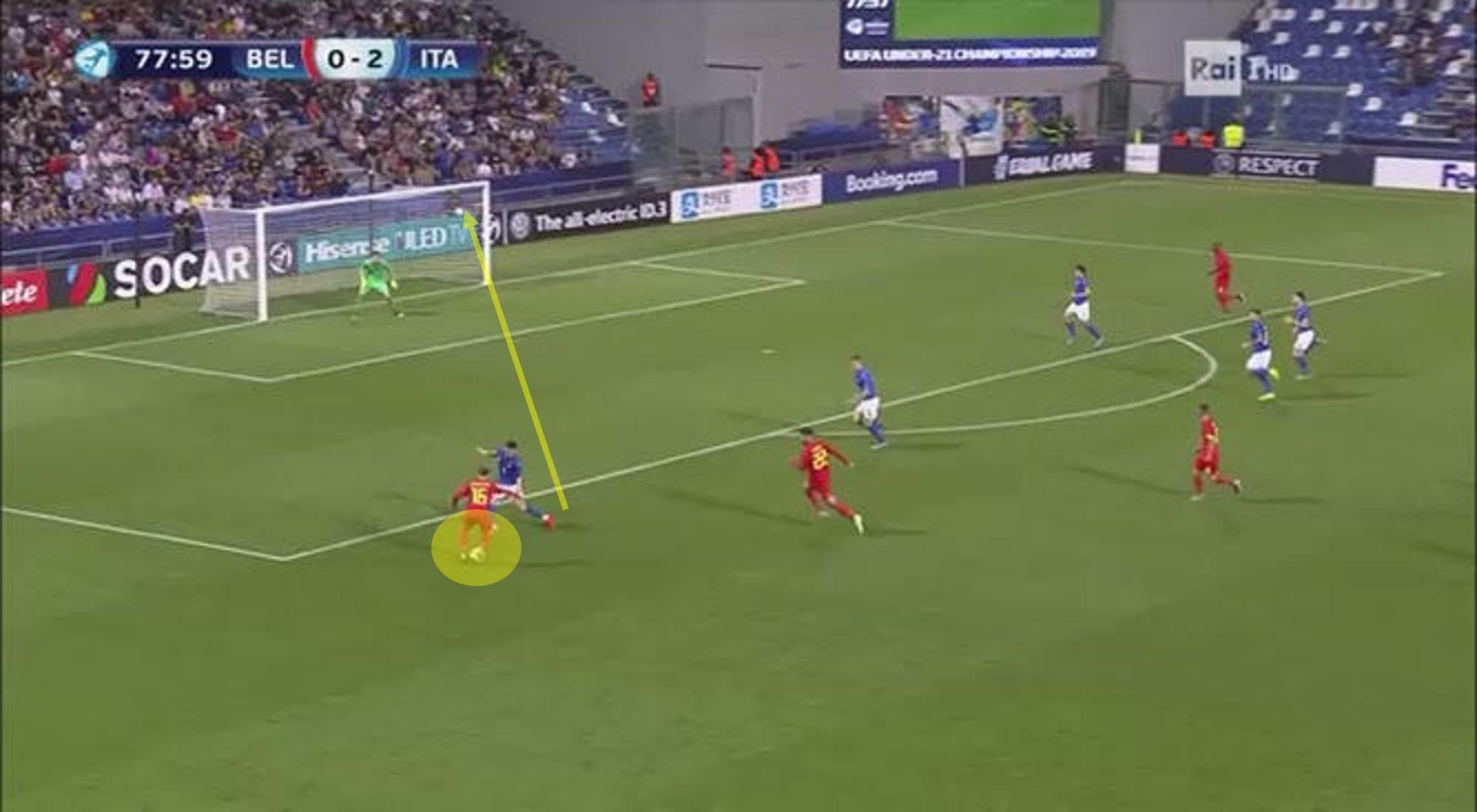
This time coming in off the left, the Belgian drops his left shoulder as he feigns to take the ball on the outside of the defender. Because he’s capable of going down either side, the full-back can’t simply show the winger onto his weaker foot. As the full-back thought he was going to go down the outside, he tried to stop this by shifting his body weight towards Verschaeren’s left side. The teenage prodigy then took the ball onto his right foot, working half a yard of space to curl in a sublime effort into the top right corner.
He’s also capable of working space for himself down the opposite flank in a similar fashion.
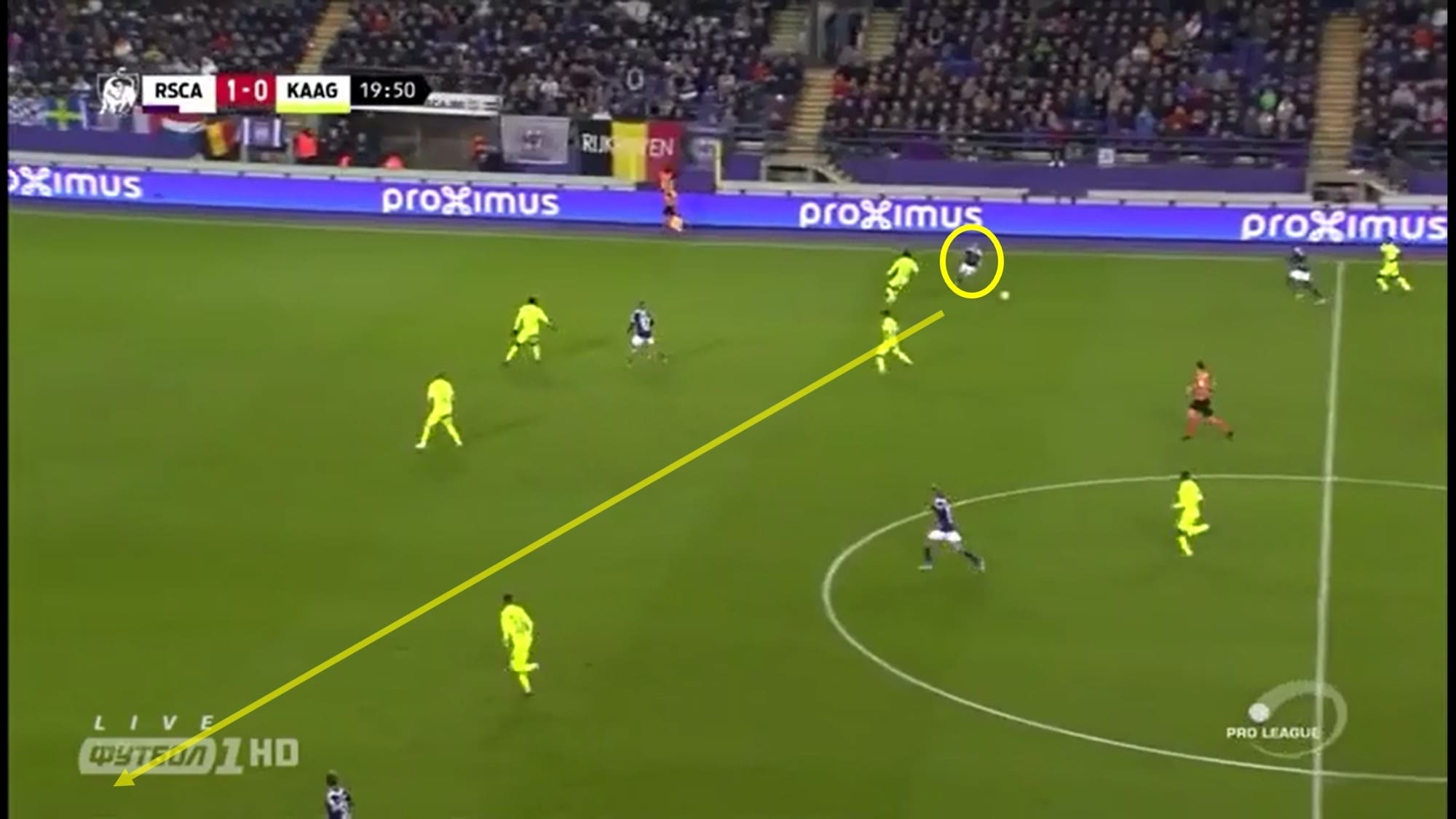
This time, he’s shaped to go down the outside, before checking back onto his weaker foot. The defender buys his initial movement, which results in the winger creating that vital bit of space for himself. Then, he shows his passing ability by playing a lovely left-footed switch to the opposite winger.
Areas for development
Verschaeren is a very neat, tidy, and effective player, but as he matures he’ll want to improve his direct goal threat. He only scored two goals last season, averaging 1.09 shots per 90 minutes and 0.17 xG. So he’ll be hoping to get into dangerous positions more frequently. Also, he slightly underperformed his overall xG of 2.74: if you were to round that number up.
The youngster only won 39.87% of his aerial duels last season. This was partly down to his lack of physical strength. Below is an example of how he got shoved off the ball against Gent.
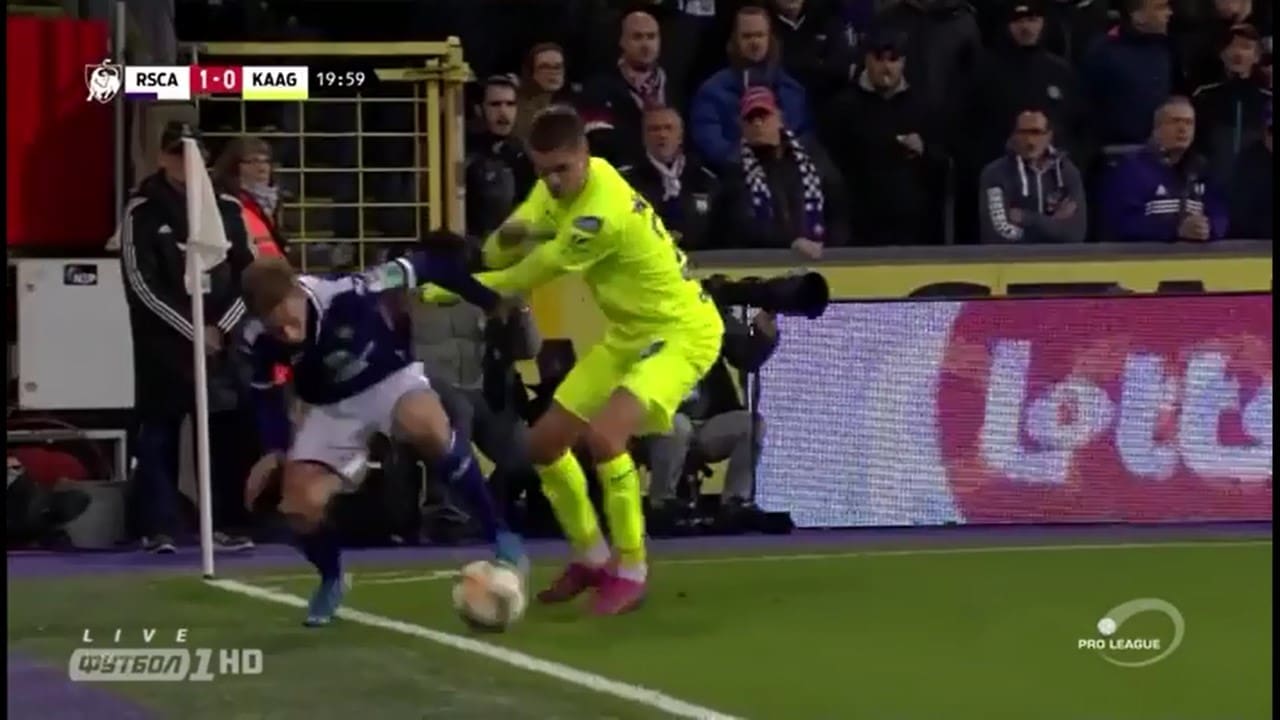
But at the age of 18, Verschaeren isn’t fully developed physically and he’s got plenty of time to bulk up. When that happens, he’ll be much better at protecting the ball for his team.
Conclusion
A full international who showed plenty of quality for Anderlecht last season, 18-year-old Yari Verschaeren is one of the hottest talents in European football. And with his footballing intelligence and low centre of gravity, it’s not hard to see why he’s been compared to compatriot Eden Hazard. If he can develop the physical strength, explosiveness and goal threat that the former Chelsea man has, then we could be witnessing the development of an international superstar.

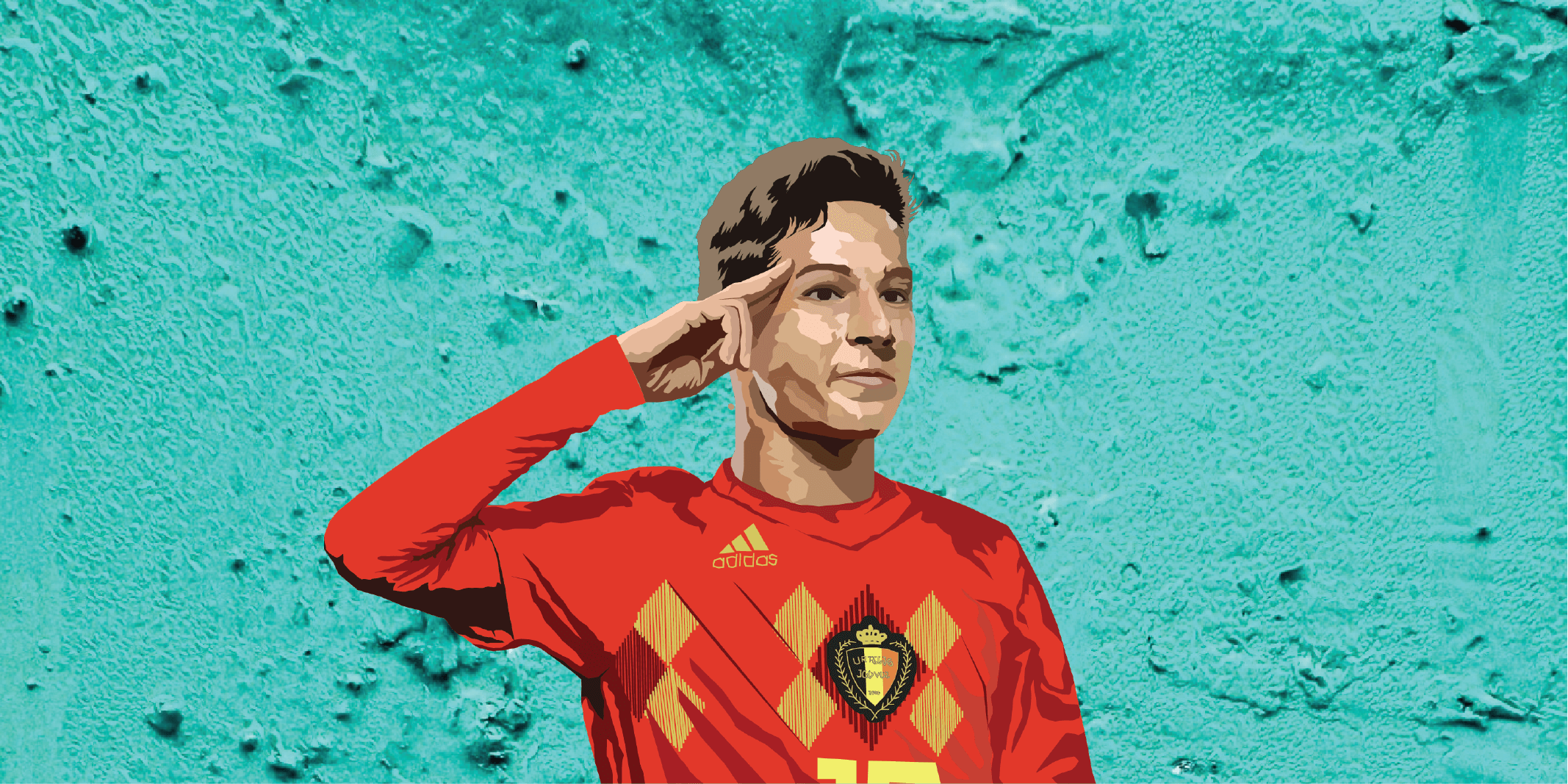




Comments